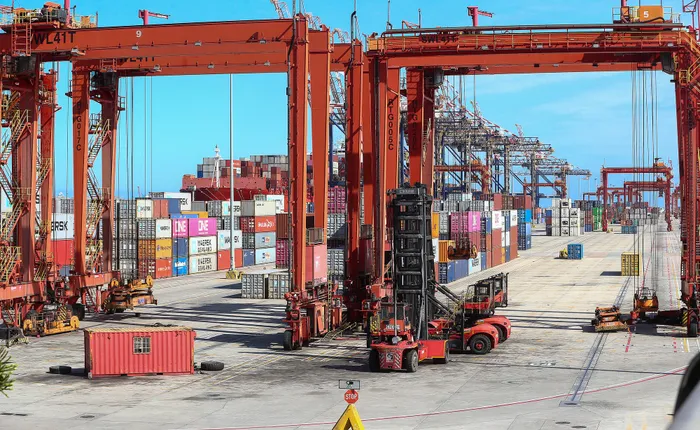IMF slightly upgrades South Africa’s growth outlook but warns of fragile recovery
ECONOMY

While power supply stability improved following reforms at Eskom and new renewable energy capacity additions, the IMF notes that energy and logistics bottlenecks continue to suppress productivity and investment.
Image: Leon Lestrade/Independent Newspapers
The International Monetary Fund (IMF) has slightly upgraded South Africa’s economy by 0.1 percentage points to 1.1% in 2025, up from a previous forecast of 1% projected in April, and up slightly from 0.5% in 2024.
The IMF's October 2025 World Economic Outlook (WEO) released on Tuesday showed that growth is also expected to hold at 1.2% in 2026, signaling a slow and uneven recovery as global and domestic constraints weigh on output.
The IMF’s forecast underscored the country’s fragile momentum within a volatile international environment marked by rising trade barriers, weaker global demand, and tightening fiscal positions across developing economies.
While power supply stability improved following reforms at Eskom and new renewable energy capacity additions, the IMF noted that energy and logistics bottlenecks continue to suppress productivity and investment.
Frequent disruptions in rail and port operations have limited the competitiveness of key export sectors such as mining and manufacturing.
The Fund warned that without decisive structural reforms to improve infrastructure governance, streamline regulations, and enhance investor confidence, South Africa’s potential growth will remain capped around 1.5% over the medium-term.
Inflation is expected to ease gradually, moderating at 3.4% and 3.7% in 2025 and 2026, respectively, aided by lower global fuel and food prices and a stable rand, following a period of volatility in 2024.
However, the IMF cautioned that public debt dynamics remain concerning, with rising interest costs and weak revenue collection threatening fiscal sustainability.
The government’s debt-to-GDP ratio is projected to exceed 75% by 2026, and fiscal space remains limited amid growing demands for social spending and infrastructure investment.
“Without credible consolidation and growth-enhancing reforms, debt dynamics could become unsustainable,” the IMF warned.
Although job creation has modestly improved in sectors like tourism, finance, and services, unemployment remains entrenched above 32%, with youth unemployment still above 45%.
The report highlighted that cuts in global development aid and higher borrowing costs were adding strain to low- and middle-income economies, including South Africa.
The IMF recommended that South Africa accelerate energy reforms, strengthen the governance of state-owned enterprises, and implement “credible fiscal consolidation anchored in growth.”
Sub-Saharan Africa as a whole is projected to grow 4.1% in 2025, but the Fund warns that South Africa’s rebound remains well below regional averages due to persistent structural and policy challenges.
The region's growth outlook is buoyed by robust activity in Nigeria, Kenya, and Côte d’Ivoire, but South Africa’s recovery remains “hesitant and vulnerable to shocks.”
Deniz Igan, chief of the IMF Research Department’s World Economic Studies Division, said they upgraded growth projections by 0.2 percentage point for both 2025 and 2026.
“So we have 4.1% projected this year and 4.4% next year. And this resilience of the region has been supported by macroeconomic stabilization as well as reform that's been going on, including in key economies such as Ethiopia and Nigeria,” Igan said.
“That doesn't mean that there are no vulnerabilities and there are no challenges, especially the resource-intensive and conflict-affected countries are facing significant headwinds.”
However, Igan said based on the medium-term outlook, the IMF also sees certain challenges coming and do believes that low-income economies, including Sub-Saharan Africa, are facing challenges in terms of the per capita income gap with their advanced economic peers widening as we go.
“And the thing to do in such an environment is going to be turning a little bit inside, strengthening institutions, further doubling down on the reform efforts, including revenue mobilization through tax reforms, and strengthen debt management, including debt transparency and governance, and doing other structural reforms that could unlock the potential of the region,” she said.
The IMF emphasizes that stronger private investment and labor market reforms were essential to achieve inclusive growth and address widening social inequalities.
The global economy, the IMF said, was “in flux,” with global growth slowing to 3.2% in 2025 amid ongoing trade fragmentation and policy uncertainty.
"As a result, the increase in tariffs and its effect has been smaller than expected so far. We now project global growth at 3.2% this year and 3.1% next year, a cumulative downgrade of 0.2 percentage point since our forecast a year earlier," said IMF chief economist, Pierre-Olivier Gourinchas.
"Still, despite multiple offsetting drivers, the tariff shock is further dimming already lackluster growth prospects. We expect a slowdown in the second half of this year, with only a partial recovery in 2026, and, compared to last October’s projections, inflation is expected to be persistently higher."
For emerging markets like South Africa, this translates into weaker export demand, tighter financing conditions, and reduced development assistance as advanced economies prioritize domestic spending.
The IMF said monetary policy should remain focused on maintaining price stability while supporting recovery.
With global uncertainty rising and protectionism reshaping trade flows, the Fund concludes that South Africa’s path forward will depend on reigniting domestic confidence and structural reform momentum to unlock long-term potential.
BUSINESS REPORT